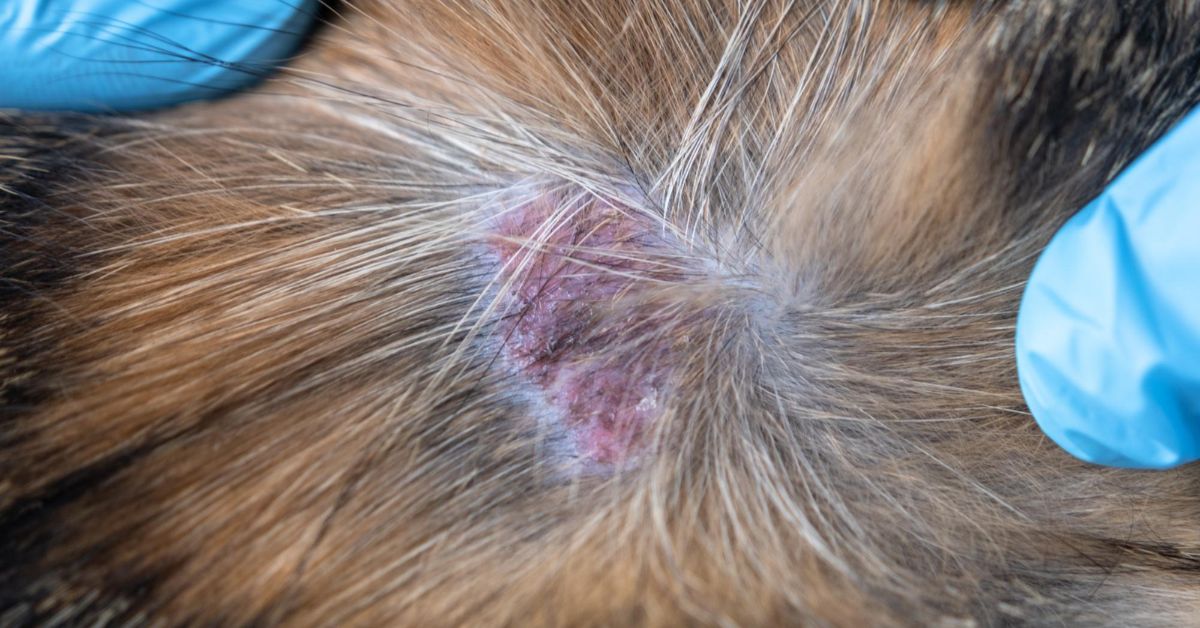Seeing your dog scratch and itch constantly is stressful, especially if you don’t see any fleas. Dog itching but no fleas is a common problem many pet owners face, and it can have various underlying causes. So, you might be wondering why my dog is itching but no fleas. Knowing why your dog is in discomfort is essential to providing the right treatment.
In this article, we will explore why does my dog itch so much but no fleas and offer insights into practical solutions. Whether it’s allergies, skin infections, dietary issues, or environmental factors, we’ll explore them all. Let’s get started.
Could Excessive Paw Licking Indicate a Cause for My Dog’s Itching?
Excessive paw licking can often signal an underlying issue, such as allergies or skin infections. To address your dog’s discomfort, understanding your dog’s paw licking behavior is crucial. This insight helps identify potential triggers, enabling timely veterinary intervention and improving your dog’s overall well-being.
Common Causes of Dog Itching but No Fleas
It can be puzzling and concerning when your dog is itching but no fleas are present. It could be allergies, skin infections, parasites, or hormonal imbalances. The best way to provide relief for your dog is to understand these common causes.
Allergies
One of the most common reasons dogs experience itching without the presence of fleas is allergies. Dogs can be allergic to environmental factors such as pollen, dust mites, and mold. These allergens can cause a condition known as atopic dermatitis, leading to persistent itching and discomfort.
Food allergies are another potential culprit, with common allergens including beef, dairy, chicken, and wheat. Identifying the specific allergen is crucial in managing and alleviating your dog’s symptoms.
Skin Infections
Bacterial and fungal skin infections can cause significant itching in dogs. Bacterial infections often result from scratching that breaks the skin, allowing bacteria to enter and cause further irritation.
Fungal infections, such as those caused by yeast, can also lead to itchy, inflamed skin. These infections often require veterinary diagnosis and treatment with appropriate medications to resolve the issue effectively.
Parasites Other Than Fleas
While fleas are a well-known cause of itching, other parasites can also be blamed. Mites are responsible for conditions like mange, which burrow into the skin and cause intense itching. Ticks, although usually larger and easier to spot than mites, can also cause irritation and discomfort. Regular check-ups and preventive measures are essential to protect your dog from these pesky parasites.
Dry Skin
Dry skin can be another reason your dog is scratching incessantly. Low humidity, excessive bathing, or poor nutrition can lead to dry, flaky skin.
Ensuring your dog has a balanced diet rich in essential fatty acids and using moisturizing shampoos can help maintain skin hydration and reduce itching.
Hormonal Imbalances
Hormonal imbalances, such as hypothyroidism or Cushing’s disease, can manifest in various skin issues, including itching. Dogs with thyroid problems may have dry, brittle fur and skin, while those with Cushing’s disease might experience thinning skin and hair loss.
These conditions require veterinary intervention and specific treatments to manage the underlying hormonal issues.
Contact Dermatitis
Contact dermatitis occurs when a dog’s skin comes into contact with an irritating substance. This could include certain chemicals, shampoos, or even plants.
The resulting inflammation and itching can be localized to the area of contact. Identifying and removing the irritant is key to resolving contact dermatitis.
Diagnosing the Cause
When your dog is constantly itching but has no fleas, it’s essential to consult a veterinarian to diagnose the underlying cause accurately. The vet will identify potential triggers by examining your dog thoroughly and discussing his medical history. Diagnostic methods commonly used include:
- Skin Scrapings: This involves taking a small sample of skin to check for the presence of mites or other microscopic parasites that might be causing the itching.
- Allergy Testing: Blood or intradermal skin tests can help determine if your dog has allergies to certain environmental factors or foods. Identifying specific allergens is essential for creating an effective treatment plan.
- Blood Tests: Comprehensive blood tests can reveal hormonal imbalances, such as hypothyroidism or Cushing’s disease, which might contribute to your dog’s itching.
- Fungal and Bacterial Cultures: These tests can identify skin infections that might not be visible to the naked eye but are causing significant discomfort for your dog.
How to Treat Dog Itching but No Fleas
Treating dog itching without fleas involves addressing the underlying cause of the irritation. Typical treatments include:
Hypoallergenic Diet
Switching to a hypoallergenic diet can help eliminate food allergens causing itching. These diets typically contain novel proteins and limited ingredients to avoid triggering allergic reactions. Consult your veterinarian before transitioning to ensure your dog gets the proper nutrients. An appropriate diet may significantly reduce your dog’s itching and discomfort.
Allergy Medications
Allergy medications, such as antihistamines or steroids, are commonly used to treat itching caused by environmental or food allergies. These medications help manage inflammation and allergic reactions, relieving persistent itching. Your vet will determine the best type and dosage based on your dog’s needs and condition. Regular monitoring is essential for long-term management.
Immunotherapy
Immunotherapy is a treatment option for dogs with severe allergies. This involves administering allergy injections over time to help build tolerance to specific allergens. Your veterinarian will conduct tests to determine the allergens affecting your dog. While it may take months to show results, immunotherapy can effectively manage chronic allergies.
Antibiotics
Antibiotics may be necessary if a bacterial skin infection causes your dog’s itching. These medications target and eliminate the bacteria causing the infection. Your veterinarian will determine the right type and dosage of antibiotics for your dog’s condition. Be sure to complete the entire course of antibiotics to prevent the infection from returning.
Antifungal Treatments
Fungal infections, like yeast infections, can cause significant itching. Antifungal treatments prescribed by your vet are necessary to treat these infections effectively. These medications may come in topical or oral forms, depending on the severity of the disease. Consistent use of antifungal treatments will help restore the balance of your dog’s skin and reduce irritation.
Parasite Medications
Parasites such as mites and ticks can cause itching and discomfort. Medications designed to eliminate these parasites can effectively address the root cause of the itching. Your veterinarian will recommend the appropriate treatment based on the type of parasite involved. Regular use of preventive treatments will help protect your dog from future infestations.
Moisturizing Shampoos
Moisturizing shampoos can help soothe dry, irritated skin, which may be causing your dog’s itching. Look for shampoos containing soothing ingredients like oatmeal or aloe vera, which provide relief without causing further irritation. Regular bathing with a moisturizing shampoo can keep your dog’s skin hydrated and reduce itching caused by dryness or irritation.
Omega-3 Supplements
Omega-3 fatty acids are known for their anti-inflammatory properties and can improve skin health. Adding omega-3 supplements to your dog’s diet helps maintain healthy skin and a shiny coat. These supplements reduce inflammation that often leads to itching. Your veterinarian can guide you on the correct dosage and type of supplement for your dog’s needs.
Thyroid Medications
If a thyroid imbalance causes your dog’s itching, thyroid medications can help regulate hormone levels. Hypothyroidism can lead to dry, flaky skin, resulting in persistent itching. Your veterinarian will prescribe the correct thyroid medication dosage to correct the imbalance. Regular follow-up tests will be necessary to monitor your dog’s progress.
Cushing’s Disease Treatments
Cushing’s disease, which results from an overproduction of cortisol, can cause itchy, thinning skin. Treatment for Cushing’s disease typically involves medications that help regulate cortisol production. Your veterinarian will determine the best course of treatment based on your dog’s specific symptoms and health status. Regular monitoring is essential for managing the condition effectively.
Topical Treatments
Topical treatments can provide relief for itching caused by contact dermatitis or localized irritation. These treatments reduce inflammation, soothe the skin, and promote healing. Your veterinarian may recommend specific creams or ointments designed to address irritation. Avoid using over-the-counter topical products not designed for dogs, as they can cause further damage to the skin.
Read More: Dog Skin Yeast Infection Home Remedy
Conclusion
If your dog is itching but no fleas are present, it’s essential to identify the cause. Allergies, infections, parasites, or dry skin could be to blame. Treating the underlying issue with proper medications and care will help provide relief. Always consult a veterinarian for an accurate diagnosis and personalized treatment plan. With the right approach, your dog can find comfort and improve their quality of life.




